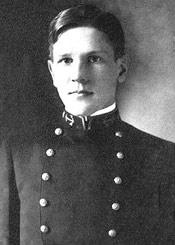Theodore Stark Wilkinson
Theodore Stark Wilkinson | |
|---|---|
United States of America | |
| Service/ | |
| Years of service | 1905 – 1946 |
| Rank | |
| Battles/wars | Veracruz, Mexico World War I World War II |
| Awards | Medal of Honor Navy Distinguished Service Medal (3) |
| Relations | James Wilkinson (great-grandfather) Theodore Stark Wilkinson (uncle)Ernest Wilkinson (father) Gulie Bustick Wilkinson (mother) Catherine Harlow (wife) Ann Harlow Wilkinson (daughter) Theodore Stark Wilkinson III (son) |
Theodore Stark "Ping" Wilkinson (December 22, 1888 – February 21, 1946) was a vice admiral of the
Early life and career

After attending
World War I and interwar years
On August 4, he was transferred to the
From July 1916 to July 1919, Wilkinson served with distinction as the head of the Experimental Section, Bureau of Ordnance, where he developed ordnance materials and devices, most notable being a noxious gas filler for shells and an "exceptionally satisfactory smoke screen". Additionally, he was deemed largely responsible for the successful design of a depth charge and for the development of the firing mechanism of the Mark VI mine used in the North Sea Mine Barrage.
Following that tour ashore—for which he received a letter of commendation—Wilkinson went to sea, first serving as gunnery officer in the battleship Kansas and later as fire control officer in USS Pennsylvania (BB-38). In 1921 and 1922, Wilkinson commanded, in succession, the destroyers USS Osborne (DD-295), USS Goff (DD-247), and USS Taylor (DD-94), before he returned to BuOrd's experimental section.
After commanding the destroyer
From September 1934 to June 1936, Wilkinson served as executive officer of USS Indianapolis (CA-35). Over the next three years, he headed the Planning Division of BuNav and then returned to Indianapolis, this time in a staff capacity, as Chief of Staff to Commander, Scouting Force. In January 1941, he fleeted up to command the battleship USS Mississippi (BB-41).
World War II
Detached from that duty and promoted to rear admiral, Wilkinson was assigned as director of the Office of Naval Intelligence (ONI) on October 15. His new responsibilities inevitably embroiled him in the subsequent controversy over whether the US Pacific Fleet Commander at Pearl Harbor was sufficiently warned of the danger of a Japanese attack before December 7 – an issue on which Wilkinson testified for three days before a joint congressional committee in December 1945.
According to his testimony and that of others, ONI was responsible for collecting and evaluating intelligence, but R. Adm.
When asked for his opinion at the time about Japanese intentions, Turner said that he had always thought that there was a 50-50 chance that they would attack Pearl Harbor at the outset. The congressional committee noted that he was "the only officer in Washington in the higher echelons who thought so." Wilkinson, in contrast, admitted that he had believed it was more likely that Japan would strike first somewhere in the southwest Pacific and avoid an immediate direct confrontation with the US – an opinion which the committee report found to have been widely shared by senior US officers before the attack.[3]
South Pacific Campaign
From ONI, Wilkinson was assigned briefly as Commander, Battleship Division 2, Pacific Fleet, in August 1942, then as Deputy Commander, South Pacific, under Admiral
In those positions, he is credited by naval historian
Pursuing this strategy, Wilkinson earned the Distinguished Service Medal (DSM) for commanding the amphibious forces in the assaults on
.Subsequently, Wilkinson earned another gold star in lieu of a third DSM, for commanding Task Force 79 (TF 79) in action in the Philippines between October 1, 1944, and January 18, 1945—operations that included the landings conducted by the Southern Attack Force on Leyte in October 1944 and at Lingayen in January 1945.
Ordered to the
He is buried in Arlington National Cemetery and his grave can be found in section 2, Lot 3645.
Decorations
Medal of Honor citation
Rank and organization: Ensign, U.S. Navy. Born: December 22, 1888, Annapolis, Md. Appointed from: Louisiana. G.O. No.: 177, December 4, 1915. Other Navy award: Distinguished Service Medal with gold stars in lieu of 2 additional DSM's.
Citation:
For distinguished conduct in battle, engagements of Vera Cruz, 21 and April 22, 1914. Ens. Wilkinson was in both days' fighting at the head of his company and was eminent and conspicuous in his conduct, leading his men with skill and courage.
Ribbon bar
Vice Admiral Theodore Stark Wilkinson´s ribbon bar:
| 1st Row | Medal of Honor | |||||||||||
|---|---|---|---|---|---|---|---|---|---|---|---|---|
| 2nd Row | Navy Distinguished Service Medal with two gold stars |
Mexican Service Medal | World War I Victory Medal with "Escort" Clasp | |||||||||
| 3rd Row | American Defense Service Medal with "A" device |
American Campaign Medal | campaign stars
| |||||||||
| 4th Row | World War II Victory Medal
|
Companion of the Order of the Bath | Philippine Liberation Medal | |||||||||
Namesake
In 1952, the destroyer leader USS Wilkinson (DL-5) was named in his honor.
See also
References
- This article incorporates text from the public domain Dictionary of American Naval Fighting Ships.
- "Mexican American War Medal of Honor recipients". Medal of Honor citations. United States Army Center of Military History. August 3, 2009. Archived from the original on March 20, 2009. Retrieved July 1, 2010.
- )
- ^ Joint Committee of the US Congress, Hearings on the Investigation of the Pearl Harbor Attack," Part IV (Dec. 14-21, 1945), pp. 1913-15, 1926, 2030-31
- ^ Joint Committee Report, July 20, 1946, p.234
- ^ Samuel E. Morison, "History of the United States Naval Operations in World War II, Volume VI: Breaking the Bismarck's Barrier, 22 July 1942-1 May 1944"; 1950, Little, Brown, p. 225-27
- ^ "More detail about drowning accident. WIlkinson".
